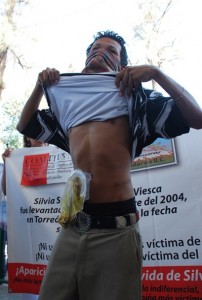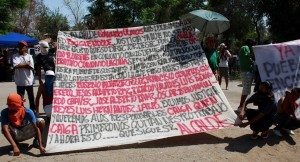Gunmen armed with AR-15 and AK-47 assault rifles massacred thirteen people in a Torreón drug rehabilitation center on Wednesday. The massacre occurred less than twenty-four hours before poet Javier Sicilia and his Citizens Caravan for Peace with Justice and Dignity were scheduled to arrive in Torreón for a rally against the drug war. The rehabilitation center is located just three blocks from the rally site.
 Despite suspicions amongst some caravan participants that the massacre was an attempt to scare them away from Torreón, Sicilia refused to cancel the event in that city. “The march absolutely will not be postponed,” Sicilia told a press conference in Monterrey just before the caravan left for Torreón.
Despite suspicions amongst some caravan participants that the massacre was an attempt to scare them away from Torreón, Sicilia refused to cancel the event in that city. “The march absolutely will not be postponed,” Sicilia told a press conference in Monterrey just before the caravan left for Torreón.
When the caravan arrived in Torreón, puddles of dried blood still filled the bullet-ridden rehabilitation center and ran out the door onto the sidewalk.
Sicilia had no choice but to hold the event as planned in Torreón. In a city ravaged by massacres, military abuses, journalist assassinations, and disappearances, residents risked their lives by simply organizing the anti-war rally.
According to participants, the massacre did have an impact on turnout though. “We live in constant fear,” said one protester. “There were people who wanted to be here today, but yesterday’s attack made them want to stay shut inside their homes.”
Olga Reyes Salazar, who has suffered the murder of six family members over the past two-and-a-half years in Ciudad Juarez, told Torreón residents that they can’t let fear overcome them. “We’re all afraid,” she told the crowd. “But if they keep intimidating us, we’re all just going to lock ourselves in our homes, and they’ll go there to kill us. So let’s leave our homes now and raise our voices against this government that is cruelly killing us.”
The Disappeared, Presente
One of the main organizers of the event was the United Effort for Our Disappeared in Coahuila (FUUNDEC), an organization of disappeared persons’ families that is based out of the Juan Gerardi Human Rights Center located in that state. In a scene reminiscent of Mexico’s Dirty War, mothers of the disappeared carried banners with their children’s photographs.
But the forced disappearance of their loved ones took place far more recently.
Of the more than 180 disappearances that FUUNDEC has documented in Coahuila, all but a handful occurred after President Felipe Calderón deployed the military to combat organized crime in December 2006.
The most terrifying aspect of the disappearances is that no one knows why they are occurring. Some of FUUNDEC’s cases are disappearances committed by the military or the police, but many persons have disappeared without a trace or were abducted by unidentified gunmen.
Some FUUNDEC families received phone calls demanding ransom after they went public about their relatives’ disappearance, but they don’t know if the call came from the real kidnappers or someone looking to profit from the families’ hardship. “We reported the extortion to the authorities, but they didn’t do anything,” complaints Ramona Ortiz Reyes, whose son and grandson disappeared in Torreón on May 12, 2008. “We gave them their names. These were the people who said they had them, and the authorities did nothing.”
Concepción Hernández says that when her son disappeared two years ago, the State Attorney General’s Office said that they would investigate the disappearance, but only if Hernández was willing to finance the investigation with her own money.
According to the Fray Juan de Larios Human Rights Center, which collaborates with FUUNDEC, Coahuila’s disappeared fit the profile of Mexico’s typical drug war victim: the majority are males between the ages of 17 and 40 years old. Nonetheless, the disappearances FUUNDEC has documented do not match the drug war victim stereotype that the government promotes. Whereas the Calderón administration has argued that most drug war victims were in some way associated with organized crime, the Fray Juan de Larios Human Rights Center notes, “The common profile that characterizes all of the disappeared persons is that they are everyday citizens and workers. There is no data that identifies them has having an activity or interest in common, and there is certainly no data that indicates that they were involved in illegal activities.”
FUUNDEC’s task is daunting. According to Ortiz Reyes, FUUNDEC has yet to find a disappeared person alive. “They’ve found a lot of dead people, but none of ours,” she says. “The problem is that they’re looking for dead people, not live ones.”
FUUNDEC doesn’t just looked for the disappeared; it works to transform the Mexican justice system so that disappearances stop occurring. “We don’t want the authorities to spend their time to looking for clandestine graves instead of looking for our family members,” says FUUNDEC member Rosalina Zapata Contreras. “[The disappearances] are not isolated incidents, so the strategy must be a coordinated response from all levels of government whose only objective must be to find our loved ones alive.”
Military Abuses
As the rally in Torreón began, a group of about twenty people—most of them masked teenagers—arrived at the event. They took their place among the crowd with a banner that listed the names of their friends and neighbors who were killed by soldiers and police. When press photographers and cameramen attempted to film them, they shooed them away because they were afraid of retaliation. They agreed to an interview with the Americas Program on the condition of anonymity, and only then because we assured them that we weren’t from a local media outlet.
 The group is from poor neighborhoods located in the outlying areas of Torreón. The military and Federal Police are permanently deployed in the area at the governor’s request. They were supposed to bring security to Torreón, but instead, members of the group say they terrorize the city’s poorest residents.
The group is from poor neighborhoods located in the outlying areas of Torreón. The military and Federal Police are permanently deployed in the area at the governor’s request. They were supposed to bring security to Torreón, but instead, members of the group say they terrorize the city’s poorest residents.
One woman explained why the teenagers came to the rally despite the fact that they were afraid to show their faces. “There’s a lot of 13- and 14-year-old teens here because they don’t want to live a life full of violence like they are now with the soldiers and the Federal Police.”
“The soldiers steal from houses, they’ve killed people, they beat and abduct taxi drivers,” she explains. “They killed a 14-year-old boy from the southeast side. They grabbed him and they shot him in the right temple.” The military eventually admitted that they killed the boy, she says, “but they say it was because he ran.”
“They run because they’re scared!” interrupts a second woman.
“We see them [the soldiers and police] grab boys and girls, and where are they?” asks the first woman. “We saw them! But then they don’t show up, or they show up in a ditch somewhere, and then they blame other people who didn’t have anything to do with it.”
“They’re the problem there,” she continues. “They entered my brother-in-law’s home. They stole money from him and they made a mess of his home. They saw my niece naked in the bathroom because the soldier opened the door when she was showering. And they put a bag over my brother-in-law’s head. It was the soldiers!”
The second woman, a mother of two, recounts how soldiers raided her home: “They told me they wanted to come inside, and I asked them why. And they said they just wanted to search. And I said, ‘Search for what?’ and they said, ‘We want to check if you have drugs.’ And I said, ‘Why would I have drugs?’ They forced their way in. They stole $1,500 pesos ($125 dollars), a cell phone, a DVD player, and a television, and they broke all of my furniture.”
“And my daughter here, they stopped her on the street and they frisked her. But they didn’t frisk her, they felt her up! They raped a poor girl, too. She doesn’t even live here anymore, she left. But it was the soldiers who did it, because they detained her.”
The second woman calls over a teenage girl. “This is my daughter. She was followed by soldiers. She’s fourteen, and the soldiers tried to put her and my niece in their vehicle. They came home so scared. They also beat my son. He was a student, but now he doesn’t go to school because of the soldiers. He tells me, ‘I’m not going anymore, Mom, the soldiers are out there.’”
“They yell ‘Hey, faggots, what are you doing,’ and then they search you,” says a teenage boy who covered his face with a shirt. “They steal your cell phone, they steal your jewelry, they rip out your earrings, they cut your hair.”
“They even steal their sneakers!” a woman interjects.
“Soldiers beat my cousin, and look at what they did to him,” says another woman, pointing at a fourteen-year-old boy’s colostomy bag. “He was standing on a corner and they picked him up and put him in a truck and they tried to kill him.”
“I was just standing on the corner and they beat me and stabbed me,” explains the young man. “They perforated my large intestine.”
“All of the violence that we’re experiencing, they say it’s ‘insecurity,’” says a thirty-something woman. “But it’s them, the soldiers and the police, that are doing all these things. Instead of coming to help us, they just come to hurt us. Why would we want them here?”
Kristin Bricker is a freelance reporter and a contributor to the CIP Americas Program www.americas.org . F. Santiago Navarro contributed to this report.



